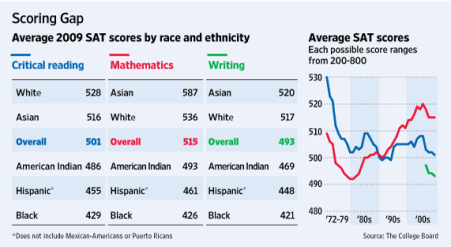CONTACT US
Does Affirmative Action Still Exist in College Admissions?
Editor’s Note: This article is the fourth in our four-part series Demographic Factors in College Admissions.
This question has become increasingly more difficult to answer. According to a study performed by Princeton Professor Thomas J. Espenshade, the admissions advantage for underrepresented minority groups can be quite substantial. However, the reasons for the leg-up in the admissions process are both multifaceted and confusing. This article will undertake the task of unraveling and analyzing affirmative action as it has evolved today.
A few decades ago, affirmative action became a reality in the college admissions process, an initiative that was intended to bridge the racial gap and bring blacks and, soon after, Latinos into the fold of the elite universities of America. The basis of this rationale was to give these underrepresented minorities the same educational opportunities as whites and, in turn, provide them with the same employment opportunities after college.
Today, things have changed. While outwardly appearing to be a continuation of affirmative action, the statistical boost that blacks and Latinos receive in college admissions is not accomplishing its original purpose of providing opportunities to those who would otherwise lack them. Instead, admissions committees are more interested in building a certain breed of diversity in each freshman class. This is why most blacks and Latinos accepted to highly selective universities already come from families of means, and those of underprivileged backgrounds are the exception.
How has this happened? According to a study conducted by former Princeton president, William Bowen, elite colleges give virtually no advantage in the application process to underprivileged students. Bowen explains this reality in a book he coauthored with former president of Harvard, Derek Bok, stating, “The problem is not that poor but qualified candidates go undiscovered, but that there are simply very few of these candidates in the first place.”
What is the leveling metric that elite colleges use to determine whether candidates are admissible? Standardized testing. Unsurprisingly, this is also the primary metric with which Espenshade establishes the statistical advantage that blacks and Latinos experience in college admissions. In his book, No Longer Separate, Not Yet Equal, Espenshade reveals that the advantage that Latinos receive is commensurate to a 130-point bump in SAT scores while blacks experience a 310-point boost. This is an attempt on the part of elite colleges to level the standardized testing playing field for two ethnicities whose national averages, for several reasons, are significantly below those of their white and Asian counterparts (as evidenced by the graph below).
In other words, candidates are evaluated against other applicants of the same race, not the entire admission pool. And it goes without saying that one of the best ways for Latinos and blacks to stand out from their applicant pools is by excelling on the SAT or ACT. This is why it is highly advisable that especially blacks and Latinos seek out standardized test prep early in their high school careers as it can give them an outsized advantage in the college admissions process. In fact, test prep may be the single best investment for underrepresented minority students who are interested in attending highly selective institutions. However, because not all test prep companies deliver the best results, it is critical to do your research before hiring a company, being wary of outlandish claims and keeping in mind that one-on-one test prep tutoring enables tutors to customize their approach to students’ needs and thereby delivers optimal results.
Clearly, if you are lucky enough to experience a quality high school education and have the means to supplement school with test prep and subject tutoring, the advantage of being black or Latino when applying to college is tremendous. But what if you are only half, a quarter, or even an eighth of one of these underrepresented minorities? If you ask college admissions officers, they will tell you that you should mark your ethnicity as however you self-identify on your college applications. This advice can be misleading, especially for those who are less sure whether they “qualify” as an underrepresented minority.
If you are navigating this difficult question, it is best to seek the advice of a college admissions consultant who understands the intricacies of how admissions officers evaluate race in the admissions process. Quality college admissions consultants know how to bring out your unique identity in your college essays to position you in a way that truly leverages your ethnic status. Even full minorities need to be smart about their essays and how their racial identities are conveyed. In short, being an underrepresented minority can give you a massive advantage in college admissions—if you can differentiate yourself from your ethnic pool in a compelling way.
Like what you see here? We are happy to permit you to use our material as long as you link back! Please refer to us as the Cardinal Education Blog.
SEE OUR RESULTS
DISCLAIMER
Cardinal Education is an independent educational consulting company. We are not affiliated with or endorsed by any private school, including those mentioned on this website. All school names and trademarks are the property of their respective owners and are used here for descriptive purposes only.

